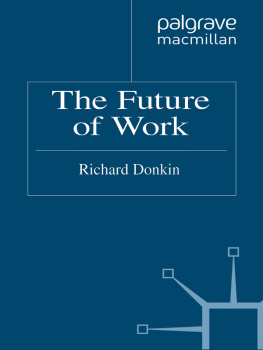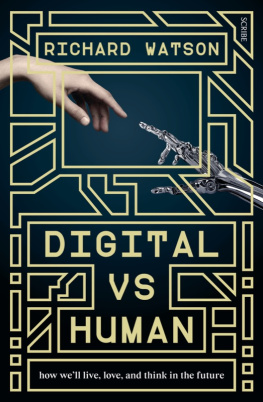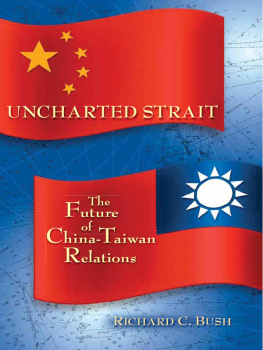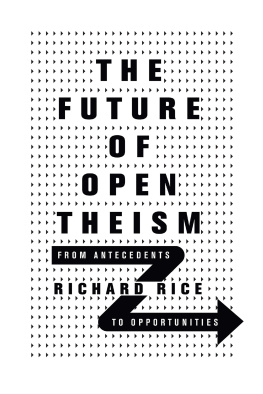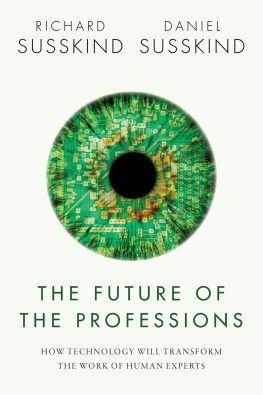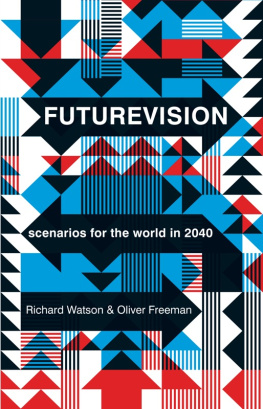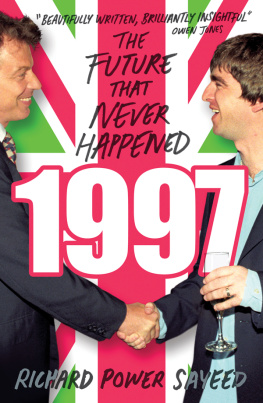Richard Donkin - The Future of Work
Here you can read online Richard Donkin - The Future of Work full text of the book (entire story) in english for free. Download pdf and epub, get meaning, cover and reviews about this ebook. year: 2009, publisher: Palgrave Macmillan, genre: Romance novel. Description of the work, (preface) as well as reviews are available. Best literature library LitArk.com created for fans of good reading and offers a wide selection of genres:
Romance novel
Science fiction
Adventure
Detective
Science
History
Home and family
Prose
Art
Politics
Computer
Non-fiction
Religion
Business
Children
Humor
Choose a favorite category and find really read worthwhile books. Enjoy immersion in the world of imagination, feel the emotions of the characters or learn something new for yourself, make an fascinating discovery.
- Book:The Future of Work
- Author:
- Publisher:Palgrave Macmillan
- Genre:
- Year:2009
- Rating:3 / 5
- Favourites:Add to favourites
- Your mark:
- 60
- 1
- 2
- 3
- 4
- 5
The Future of Work: summary, description and annotation
We offer to read an annotation, description, summary or preface (depends on what the author of the book "The Future of Work" wrote himself). If you haven't found the necessary information about the book — write in the comments, we will try to find it.
The Future of Work — read online for free the complete book (whole text) full work
Below is the text of the book, divided by pages. System saving the place of the last page read, allows you to conveniently read the book "The Future of Work" online for free, without having to search again every time where you left off. Put a bookmark, and you can go to the page where you finished reading at any time.
Font size:
Interval:
Bookmark:
Richard Donkin


Richard Donkin 2010
All rights reserved. No reproduction, copy or transmission of this publication may be made without written permission.
No portion of this publication may be reproduced, copied or transmitted save with written permission or in accordance with the provisions of the Copyright, Designs and Patents Act 1988, or under the terms of any licence permitting limited copying issued by the Copyright Licensing Agency, Saffron House, 610 Kirby Street, London EC1N 8TS.
Any person who does any unauthorized act in relation to this publication may be liable to criminal prosecution and civil claims for damages.
The author has asserted his right to be identified as the author of this work in accordance with the Copyright, Designs and Patents Act 1988.
First published 2010 by
PALGRAVE MACMILLAN
Palgrave Macmillan in the UK is an imprint of Macmillan Publishers Limited, registered in England, company number 785998, of Houndmills, Basingstoke, Hampshire RG21 6XS.
Palgrave Macmillan in the US is a division of St Martins Press LLC,
175 Fifth Avenue, New York, NY 10010.
Palgrave Macmillan is the global academic imprint of the above companies and has companies and representatives throughout the world.
Palgrave and Macmillan are registered trademarks in the United States, the United Kingdom, Europe and other countries
ISBN 978-0-230-57638-4
This book is printed on paper suitable for recycling and made from fully managed and sustained forest sources. Logging, pulping and manufacturing processes are expected to conform to the environmental regulations of the country of origin.
A catalogue record for this book is available from the British Library.
A catalog record for this book is available from the Library of Congress.
10 9 8 7 6 5 4 3 2 1
19 18 17 16 15 14 13 12 11 10
Printed and bound in Great Britain by
CPI Antony Rowe, Chippenham and Eastbourne
For Gillian
Putting together a book like this was always going to be a big undertaking, not least because events that change our future are happening all the time. It meant that, while much of the thinking in these pages was drawn from working and writing for 14 years on the changing workplace, findings and statistics were being added right up to the day I submitted the manuscript (and sometimes beyond). Fourteen years is a long time to be working in this space, and over that time I have consulted and quoted from the research of thousands of people working in the field of employment and management. Some of them, like the late Peter Drucker, who I interviewed at his home in 1996, or Warren Bennis, who became a personal friend and mentor, need no introduction. Neither do the countless management writers, some mentioned in the text, whose work has fed the thinking outlined here. I cant mention all of them by name but must acknowledge their influence. A few others, however, have given regular advice and help and encouragement over the months and years and I would like to mention them now. Stephen Overell at the Work Foundation has been consulted at various stages and some of the research I carried out for the foundations Good Work Commission is recalled here. Duncan Brown, director of Human Resources at the Institute of Employment Studies, suggested after I had completed my earlier book that I should write something more in the line of a polemic and I have tried to reflect some of that in these pages. Ruth Spellman, chief executive of the Chartered Management Institute, persuaded me to launch the human capital standards group which Tim Melville-Ross kindly chaired during its short lifetime. Stephen Jones at Investors In People was another big help. The librarians at the Financial Times have always been good to me and I thank them once again. At the British Library Sally Halper was a real help, guiding part of my research. Over the years numerous public relations specialists have helped me, passing on references, pointing out new studies and contacts. I would like to thank Caroline Hole-Jones, Colette Hill and Simon Brocklebank-Fowler for their assistance. The book had been on my wish list from the day I finished writing my history of work nearly 10 years ago, but it took some prodding from Stephen Rutt at Palgrave Macmillan to get it moving. Thanks must also go to Eleanor Davey-Corrigan, Suzanne Fowler and Abigail Coften at Palgrave Macmillan. I would like to thank my family, the boys (young men now), John, Rob and George, who have suffered the grumpy old man for too long. I dont know how to start thanking my wife, Gill, who has been supportive in so many waysreading the text, holding the home together and making endless cups of tea.
Others such as Peter Starbuck, Dave Sellick, Sian Harrington, Andrew Mayo, Chris Bones, Robert Taylor, Harriet Arnold, Seb Morton Clark, Bill Butcher, Peter Siderman, John Dubois, John Ingham, Andrew McNeilis, Nick Isles, Lesley Muir, Andy Austin, Richard Wilkie and the late John Mason have all been helpful in one way or another. Some organizations have also supported my work during this period: Cass Business School (thanks to Caleb Hulme-Moir, Amanda Chick and David Simms), The Adecco Institute, PricewaterhouseCoopers, The Recruitment and Employment Confederation, Earthwatch Institute, The Royal Society for the Arts, Henley Management College, HR Society, Human Resources Magazine and SuccessFactors. I am indebted to all of them. I must also thank John Fey and his company SFL for supporting my website, RichardDonkin.com, where many of the ideas in this book have taken shape.
Shaping a Path for Tomorrow
The future aint what it used to be
Yogi Berra (1925)
On a bleak November day in 2008 I was sitting alongside some former colleagues in an East Sussex church. We had gathered for the funeral of an old friend. Before the service the vicar had asked us to ensure that our mobile phones were either turned off or silent.
The memorial tributes were overrunning and I noticed a colleague next to me look at his watch. A few seconds later he was scrolling down the glowing screen of his BlackBerry hand-held communicator and a few seconds after that he excused himself and disappeared outside.
I know that work is changing. It is, after all, the subject of this book. But I hadnt realized before that incident quite how much these changes have penetrated every facet of our livesand deaths. Or perhaps I had, in that the incident aroused nothing more than curiosity coupled with a mild sense of irritation. Can nothing be free anymore from the intrusion of working life? Not even our funerals?
The BlackBerry has come to symbolize the work anywhere culture of our times. This pocket-sized device that can tell us our precise location on the planet, that can access information and communicate in a roll and click of a finger, is a triumph of primate evolution, combining the advantages of bipedalism, the opposable thumb and an enlarged brain to create the ultimate in flexible, mobile living.
Living or working? Its a taxing questionliterally, if your expertise is revenue gatheringbut the question is just as tough for the rest of us. The fusion of work, rest and leisure has become an underlying source of tension in our lives. Our gradual liberation from offices and factories is forcing us to reshape our understanding of work. What is work today?
For years during speaking engagements I have felt comfortable in defining work to audiences as something we would rather not be doing. It usually draws some knowing smiles. In spite of those who claim that they love their work, this more negative definition still seems to resonate with many people.
Font size:
Interval:
Bookmark:
Similar books «The Future of Work»
Look at similar books to The Future of Work. We have selected literature similar in name and meaning in the hope of providing readers with more options to find new, interesting, not yet read works.
Discussion, reviews of the book The Future of Work and just readers' own opinions. Leave your comments, write what you think about the work, its meaning or the main characters. Specify what exactly you liked and what you didn't like, and why you think so.

